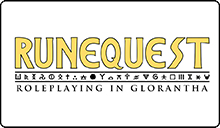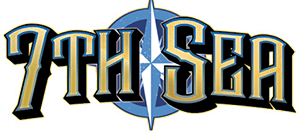What Kind of Knight Will You Become?
Will you fight to rid the world of injustice, or use clout and power to take advantage of those beneath you?
Chaosium Unveiled: Pendragon: Core Rulebook
Watch the unveiling video to see the book for yourself. Remember that you get the PDF when getting the physical copy.
What's Inside
Pendragon is set amidst the glory and grandeur of King Arthur’s Britain. Its innovative mechanics drive the emotional impact of play as your characters pursue Glory, overcome life-and-death struggles, cross blades with ruthless enemies, and fight for love and justice in a world of brutal medieval realism.
The Core Pendragon Experience

The Pendragon: Core Rulebook contains everything you need to begin an epic adventure in King Arthur’s Britain. It covers the complete core rules of the Pendragon game system, including Traits and Passions, Skills, combat, injury and recovery, Glory, Favors, and Honor.

A Setting Guide

The Pendragon: Core Rulebook serves as a guide to the world of Arthurian fantasy. The book includes a detailed look at England as it was in the time of King Arthur, the fantastical elements of the legendary setting, as well as the role of knights and nobility.

The Passage of Time
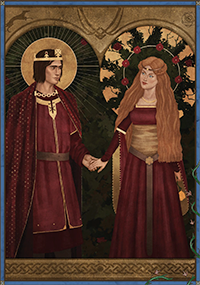
Pendragon campaigns are generational: you will grow old, you may marry, you may have children, and when you die (by the sword or the slow decay of time), you resume play as your heir! The Pendragon: Core Rulebooks contains rules for The Winter Phase—the downtime period of the game for characters to train, age, and even go on side quests.
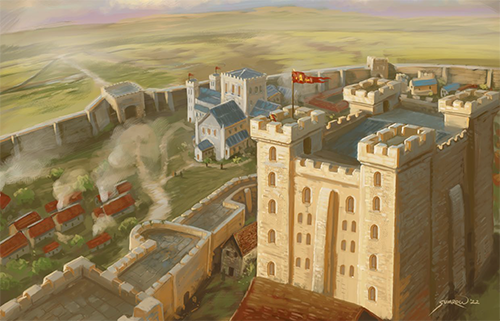
Additional Features

The book includes a myriad of additional features, including 6 pre-generated character templates for optional, faster character creation, special rules for Afflictions, Obsessions, Directed Traits, Ideals, and ransoms, a full medieval equipment list, and a Coat of Arms generator to make wholly unique heraldry for your Player-knight.
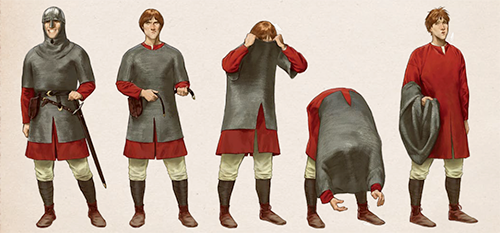
Downloads for this Product
What The Critics Say
-
"If you are looking for the ultimate Arthurian roleplaying game you do not have to go off on some grail quest... it's an absolute no brainer that the sixth edition of Pendragon must be in your collection. 9/10.”
— The Gaming Gang, Pendragon 6th Edition Core Rulebook Reviewed.
-
"If you’re in any way serious about roleplaying games, Pendragon should count among the must-have books in your library"
— Jay Anyong, The Philippine Gamer, [Let’s Study] Pendragon 6E Core Rulebook, Part 9: Review.
-
"[Pendragon 6th Edition] has such a unique approach to characterization and storytelling that’s not found elsewhere."
— Forbes, Bring The Round Table To Your Gaming Table With This Classic RPG.
-
"It’s clear to see why Pendragon is regarded as Stafford’s masterpiece... The Pendragon Core Rulebook is a master-class in rules design."
— Akehelas, REVIEW: Pendragon Core Rulebook.
-
"I find the 6th edition to significantly improve an already great game and is a superb resource for new players. I welcome the minor tweaks to the rules, the embrace of female knights as characters, and the greatly expanded explanations of the rules."
— ReviewCredit, Let us ride to Camelot: Pendragon 6th Edition.
-
“Wonderful new edition of Geg Stafford's masterpiece… If you never played Pendragon, try it! You are in for one of the most profound and moving experience roleplaying games can provide. Chaosium did create the best horror RPG ever with Call of Cthulhu. You re about to discover they also provided us with the best chivalric and legendary experience.”
— Joann Sfar, Pendragon Core Rulebook Review.
-
"It’s my first look at a Chaosium game, and it did not disappoint! You can lose yourself in this book and the game"
— DM Tales, Pendragon Arthurian TTRPG.
-
“Greg Stafford is considered one of the greatest game designers of all-time (Rightfully so), and Pendragon of all the great gaming works he wrote during his lifetime, Pendragon could very well be considered his magnum opus… The new Core Rulebook is the latest implementation of the rules, and may be the best version yet.”
— EuroCultAV, EuroCultAV Holiday Gift Guide 2024.
-
Pendragon Core Rulebook is a great update and explanation of the core rules to Pendragon, Sixth Edition, the perfect book for the players and a good rules reference for the Game Master. And in bringing back Greg Stafford’s masterpiece back to print, the publication of the Pendragon Core Rulebook heralds a new Golden Age of King Arthur and the adventures that Player-knights will undertake in his realm.
— R’lyeh, The Pinnacle of Pendragon.
-
“Pendragon delivers a deeply thematic experience for fans of Arthurian lore… the game excels in character as well as historical immersion.”
— Dave Thaumavore, 52 reasons to move on to other RPGs.
- Publisher:
- Chaosium
- Ruleset:
- 6th Edition Pendragon
- Year Released:
- 2024
- Format:
- Full Color Hardcover
- Page Count:
- 256
- ISBN:
- 978-1-56882-473-4
- Author:
- Greg Stafford
- Cover Artist:
- Mark Smylie
- Interior Artists:
- Andrey Fetisov, Eric Hotz, Jaime Garcia Mendoza, Josep Perez, Eleonor Piteira, Agathe Pitie, Dimitar Stoyanov, John Sumrow, Wicked Dual LLC
- Cartography:
- Matt Ryan
- Heraldric Artist:
- Katrin Dirim
- Border Designs, Marginalia, & Graphic Elements:
- Simeon Cogswell, Kalin Kadiev, Ash Stellmach
- Design & Layout:
- Simeon Cogswell
- Pendragon Line Editor:
- David Larkins
-
Pendragon Core Rules
Big fan of COC & RQ but late to this classic. Took a chance, bought this & I'm so impressed. The layout with medieval style, parchment type pages & the illustrations is an absolute joy to behold & read. This is on my list to run. Sets the standard for atmospheric sourcebooks. Looking forward to further sourcebooks of high quality in the future. As a gamer from North East England I would love to see a Northumbria sourcebook! Congratulations to the Pendragon team - Superlative product
-
Brilliant edition
This is a brilliant edition of one of the best TTRPGs there is. Executed well and, as can be expected from something that has Greg Stafford's hands all over it, superbly fits the world of its design. A lovely book generally. It's something I'll genuinely treasure.
-
6th ed
Concept and content are great! Interior art is amazing! Cover art is meh. A lot is missing to be able to play a proper game, but expect to see it in other books.
-
The best medieval roleplaying game. Period.
At last, the long-awaited 6th edition of Pendragon is now available, and I think it’s one of the strongest to have been released since the 3rd edition. Sure, the basics remain the same because Pendragon is not a game that changes just for the sake of making us buy new books. However, from what I’ve had the chance to read until now, they really tightened up the system by defining lots of new action types in combat, regrouping passions into categories called “courts”, removing underused skills like swimming (it’s now dexterity), boating or cultural weapon skills which all makes sense to me, although I’m not sure if I like the damage downgrade to charges… One the biggest changes I saw is the mass battle system which seems to have been revamped quite a bit and I can’t wait to test it myself! Also, I strongly advice to buy the “Starter Set” box that was released a few months ago by Chaosium even if, like me, you’re an experienced Pendragon player. Contrarily to what one might think, the Starter Set includes some rules like the new Battle System that are not featured in the “Core” book. Also, it comes with a great solo adventure and a mini campaign that is interesting since there is none in the core book. Maybe it’s just me, but I think calling this box a “Starter Set” is quite misleading… Other than that, the book layout, inspired by medieval codex, is perfect. The illustrations are of varying styles and quality, but overall, it’s certainly more on the beautiful side of the spectrum, with only a few illustrations that feel subpar. I really love that they used a style of art inspired by medieval illuminations to introduce each chapter even if I think that some of them were made with techniques that could have been a bit more faithful to authentic medieval illuminations, especially in comparison to the “marginalia” drawings which render better in my opinion. There are also many ultrarealistic paintings that do a great job of making you dream of the Arthurian legends in colors. So, whether you’ve never played Pendragon or you’re a veteran of the game, there never was a better time than now to buy the books!
-
The Product Page needs to change in order to reflect what this books actually delivers: 1/3 of the full Core Set
Just finished my first read-through after a few sessions: all in all the book is great, the system is good, and the art and layout are top notch and ooze personality. The problem is that it's sold as a one and done game system rulebook, which it isn't: it doesn't have everything you need to play the whole "The Core Pendragon Experience", it only focuses on the beginning of your Knight's adventure, and calling it "A Setting Guide" is just disingenuous, if you're not familiar with the Arthurian Myth proper than you're lost to outside research (without even an Appendix on suggested reads, which I assume is gonna be in the GM's Handbook). You can't go through a section without references to one or more external materials, and if you do your research you'll get the full picture: the Core Set Is actually made up of three books, those will get you everything the product page of this Core Rulebook alone sells you. If you're looking to play through your journey now as chivalrous knight in a fantastical medieval europe you're gonna face plenty of challenges on the road, and the GMs are gonna have a hard time researching old materials since even the beginning scenarios set in 508 aren't included in this book, we'll hopefully get more news on the upcoming products to finally get the Full Pendragon Experience. The Product Page really needs to change to reflect what this books actually delivers, one third of the full core ruleset.
-
Beautiful & Polished, but not quite "Core"
In Pendragon the players play as medieval knights in Arthurian England. The game focuses on playing through the various periods of Arthur’s life and exploring the Player-knights’ stories. The Core Rulebook focuses on the “Boy King Period” after Arthur pulls the Sword from the Stone, with nods throughout to later periods (such as unifying England in the “Conquest Period”). Widely regarded as Greg Stafford’s finest work—including by the game designer himself—Pendragon has been on my radar for some time. Despite owning a copy of the previous 5.2E, I never cracked the cover! I also didn’t pick up last year’s Pendragon Starter Set. This book is my first exposure to Pendragon. That said, I’m actually somewhat familiar with Arthurian stories. My preference is for T.H. White’s The Once and Future King rather than Le Morte d’Arthur or the Mabinogion. That’s more a matter of taste than a judgment of quality. I mention this so that readers understand my general point of view when reading the Pendragon Core Rulebook. As most readers probably know I’m deeply familiar with RuneQuest. The Pendragon Core Rulebook’s relationship with the current edition of RuneQuest is fascinating. However, today’s review will focus on the Pendragon Core Rulebook itself. I’ll save other thoughts for the future. Disclaimer: I received free review copies of the Pendragon Core Rulebook and The Grey Knight in exchange for an honest review. Thank you, Chaosium! WHAT’S INSIDE? The Pendragon Core Rulebook is a 254-page hardcover which includes a primer on the medieval world, rules for creating Player-knights from the Cymric culture, and the game system’s rules for Traits & Passions, skills, combat, and improving a Player-knight during play. The typical structure of a Pendragon game is supported through a chapter on “Solo Scenarios” which occur when a Player-knight goes offscreen (for example, if driven mad by a fairy) and by a chapter describing the “Winter Phase,” during which Player-knights improve their statistics. It’s clear to see why Pendragon is regarded as Stafford’s masterpiece. The game’s rules system uses a simple core mechanic to resolve all tasks, which remains flexible for use in a variety of different conflicts. Each of a Player-knight’s Statistics—whether physical Characteristics like Strength, emotional Traits like Trusting, or skills like Courtesy and Sword—exist on a scale of 1 to 20. The player rolls 1D20 against the tested Statistic, and succeed if they roll under its rating. Rolling equal to the Statistic’s rating results in a critical success. In opposed rolls (like combat), the character with the higher die result succeeds. This creates a logical structure in which high rolls are always good (so long as they don’t go over the Player-knight’s Statistic). Results are straightforward and clear. This simplicity is further supported by straightforward rules for modifiers. Almost all modifiers use 5-point increments, whether positive or negative. Going over 20 results in a critical bonus which is added to the 1D20 roll, increasing the Player-knight’s chance of a critical success. For example, if Lancelot has Charge 20 (+3), on a rolled result of 17 or higher he gets a critical success. Large modifiers mean that when a Player-knight is inspired by their Traits or Passions, the skill difference is significant. They also mean that negative modifiers are often substantial enough to bring a formidable foe’s rating down into mortal territory. At first, I wondered why Pendragon 6E didn’t use some form of advantage and disadvantage. Sure, Dungeons & Dragons is a bit of a bugbear, but I genuinely think advantage/disadvantage in 5E adds a lot to D20-based games. A good example is Free League’s Dragonbane, which like Pendragon is built upon a Basic Roleplaying chassis rolling 1D20 instead of 1D100. Dragonbane uses advantage/disadvantage effectively to reduce math and increase simplicity. Reading the combat chapter helped me understand why. Despite the core simplicity of Pendragon, I was pleasantly surprised by the tactical combat. The Core Rulebook describes a variety of actions a character might take, each of which resolve rather simply. The variety creates tactical options which provide players with meaningful choices in a fight. In particular, the “Defend” action adds a +10 modifier to the Player-knight’s skill but they won’t deal any damage. The size of this modifier allows a Player-knight to defend themselves from foes with far higher skill, and also offsets the –5 penalty per additional opponent fought simultaneously. A five-page detailed combat example helps demonstrate the system’s cohesion, using Passions, Traits, modifiers, skills, and a variety of circumstances to clarify how this clock’s gears elegantly click together. Pendragon uses modifiers well because there’s a visible and easy-to-understand relationship between different modifiers. In combat, they create tactical situations which an advantage/disadvantage system can’t duplicate as effectively. Outside of combat they’re especially impactful on a Player-knight’s Traits. Based on the traditional virtues of Arthurian society, the Traits all come in opposed pairs which add to 20. As a knight, players all begin with Valorous 15, which is opposed by Cowardly 5. If opposed by a fearsome monster, the Player-knight may have a penalty to Valorous. If their Valorous test fails, they may be forced to roll against Cowardly instead! The prior penalty to Valorous correspondingly has temporarily increased the Player-knight’s Cowardly, making it more likely they’ll flee. The “Traits and Passions” chapter is probably my favorite in the Pendragon Core Rulebook. I imagine for some readers the 34-page section may feel overlong; however, I enjoyed the comprehensive descriptions of each Trait and Passion, and their consequences in play. This section really feels like the “heart” of Pendragon. The Traits and Passions have been chosen to encourage the Player-knights to emulate both the joys and the sorrows of Arthurian literature. There’s a mechanical description for being struck mute by Transcendent Beauty, as well as being driven to Madness by despair. What really makes this “click,” for me, is that players are encouraged to embrace the negative aspects of roleplaying. Larger-than-life heroic figures weep one day and then laugh heartily the next. The drama and swinging emotions of an Arthurian knight are keenly present in Pendragon. It works because the book goes beyond mechanical description into encouraging the player to embrace the results of dice rolls as a way of exploring their Player-knight’s inner experience. This contrasts sharply with the typical RPG experience of “my character is precious, and I want nothing bad to happen” or “characters die so easily, I refuse to get attached to their personality.” I like it a lot. The Pendragon Core Rulebook contains an excellent rules system filled with useful roleplaying detail about medieval life. However, I don’t agree that it is a “core” rulebook. In this regard my subjective test is “Do I feel I have everything needed to gamemaster my own adventures?” And honestly, I’m not sure that I do. First, I felt a bit lost in the geography of Britain circa 500 AD. A map is provided, but since the introduction is title “Welcome to Camelot” I was puzzled for a while why the map doesn’t have Camelot on it (I later figured out that the map depicts the Boy King Period before Camelot was built). The Core Rulebook provides rules for a single culture, the Cymri, and notes that all Player-knights are from Salisbury county in Logres. The map doesn’t point out where counties are, so I’m not sure what area is friendly or hostile (AKA adventuring) territory. I eventually found Salisbury based on the mention of its castle at Sarum, but the tantalizing reference to a (fairy?) Kingdom of Summerland nearby has continued to leave me stumped. The Core Rulebook is certainly NOT the place for a deep-dive into Who’s Who or Where’s That Castle. I’m generally familiar with most of the people-names and a fair number of the place-names. A short gazetteer of Arthurian Britain or a chapter on Salisbury county would be helpful for understanding the geography. Likewise, I’m not clear on some of the religious differences mentioned in the book. Player-knights can be Christian or Pagan, but Heathen and Wodinic religions are also mentioned. The latter is clearly Norse (worshiping Woden, more familiar as Odin), but I have no idea what the distinction is between Pagan and Heathen. I appreciate that the Core Rulebook is trying to avoid overloading the reader considering the breadth of the social information otherwise, but I do think a little more on other topics would have been helpful. Second—and more substantially—there’s not much guidance about adventures or antagonists. I’d have appreciated a short bestiary or a non-player characters folio for immediate use by the gamemaster. From my entry point without any other Pendragon context, I’m not really sure how to start playing the game. Finally, there’s a number of subsystems which the Core Rulebook references to another book in the Pendragon line. This is frequently enough that it gives me the impression that the Core Rulebook is incomplete. For example, the Fashion skill provides bonuses to a character’s “Geniality,” but the function of this is in the Pendragon Gamemaster’s Handbook. A few other sections also reference the Gamemaster’s Handbook or the Noble’s Handbook for full rules. Skills such as Fashion or Industry which are intended for “Ladies” characters puzzle me because the Core Rulebook explicitly only lets you create Player-knights. Some knightly subsystems also appear missing. In particular, Pendragon’s “Battles” rules are not included. Other activities which reference rules in the Gamemaster’s Handbook include “Hunting” and “Feasting.” I see merits for excluding less-important subsystems from the Core Rulebook. A great example is that the “Winter Phase” doesn’t really include rules for managing an estate. The Stewardship skill references the Noble’s Handbook on this topic. It feels odd that the Stewardship skill is in the Core Rulebook or on the standard character sheet. But, I don’t get the impression that estate management is central to playing Arthurian stories in Pendragon. After all, the Winter Phase explicitly notes that most knights care little for the minutiae of their estate. It’s not exactly “heroic.” In contrast rules for playing the Battle of Badon Hill, hunting for the Questing Beast, or winning an amor’s attention during a tournament all do seem “core” to my sense of Arthurian stories. Overall I get the sense that this book is “How to be a Player-knight” rather than “core” like the Call of Cthulhu Keeper Rulebook, the Dragonbane Core Set, or other single-book/single-product games in my library. PRODUCTION The Pendragon Core Rulebook is beautiful. The visual quality is on par with Chaosium’s recent work (such as The Lightbringers or Mythology) with high-quality illustrations and clean layout. The visual style evokes an “illuminated manuscript” to good effect. Agatha Pitie’s evocative art introduces each chapter, and the whole work is scattered with charming medieval spot illustrations by Katrin Dirim. All of the art is good, but Dirim’s is my favorite. It really catches the odd, even whimsical feeling of medieval manuscript art. This adds a lot to the book’s antique feeling. Pitie’s artwork does so as well, but with a slightly more “on-topic” tone than jousting snails. The more “painterly” or “realistic” illustrations look good as well, but I found they didn’t evoke as strong a personal response. The layout is quite interesting, and worth noting. The Pendragon Core Rulebook is laid out with two large columns and a narrower column. They are not in consistent order. The narrow column is generally on a margin, but this is not consistent. Faint outlines are placed around each of the columns to strengthen the sense that this is a medieval manuscript. The large columns contain the text, while the narrow column typically has commentary. Sometimes this “scholiast” basically rewords the main text, while at other times it does provide useful and interesting rules notes or examples. On my first look through the Core Rulebook, I suspected the varying columns would bother me. While reading, though, I found that this page-by-page variance wasn’t annoying. I think the narrow column’s comments could be more frequent or more pertinent in places, but overall I found this layout scheme worked well. It surprised me, very much in a good way. I also quite like the physical production of the book. It’s on a thicker paper stock than I’m used too, which has more of a “matte” feel than “glossy.” I didn’t care for how Chaosium’s recent Basic Roleplaying: Universal Game Engine’s art looked on this paper, but it looks really good in Pendragon. This paper stock does feel “thicker” for its page count than usual, with a substantially increased spine size. I feel pretty confident this is a choice about book quality, not about trying to make the book look thicker than its page count. Importantly, I do just plain like this paper more. It feels sturdier and less likely to tear, and the matte’s reduced sheen is easier to read in weird light (like on the porch). I get the feeling that this is a physical product built for the game table. I do note, however, that my Pendragon copy’s two ribbons are already beginning to fray. I’ve noticed this as well in some of my Cults of RuneQuest books (but not my years-older RuneQuest: Roleplaying in Glorantha), so it may be worth bearing in mind for Chaosium or the printer. Overall, the textual polish of the Pendragon Core Rulebook is superior to the recent Chaosium products I’m familiar with. There is the occasional typo, yes, but as a whole the main text is pretty much right on my subjective “professional publisher” expectation. However, there is one major flaw in this otherwise brilliantly beautiful book: ligatures. Ligatures are the narrow lines which sometimes connect letters in a font. For some reason, ligatures are turned on in the Core Rulebook’s sidebars and credits. The text of those sections is at the same general polish as the main text, but I found the ligatures continually tripped up my eye while reading. It’s possible that this decision was an intentional archaism to add to the feeling of “medieval manuscript.” If so, I’m convinced that was a mistake. If the ligatures weren’t intentional, I’m honestly stunned—how could a proofreader have missed this? The text itself clearly was proofread to a professional standard, but I wonder how many eyes were on it after layout. CONCLUSION The Pendragon Core Rulebook is an excellent “Player-knight’s Guide” wearing the coat of a “core” rulebook. It contains everything a player might need to know to roleplay their Player-knight during quests and adventures in the days of King Arthur. While, as I’ve noted, there are deficits when viewed as a core rulebook, when viewed as a player’s guide this work is excellent. I believe players as well would enjoy a bit more geographical information—and I feel confident that they’d enjoy more culture or background options—but overall the gameplay and setting information contained within is well-constructed to create a specific gameplay experience. I do recommend Pendragon, but can’t in good conscience recommend it as wholeheartedly as I’d like. The reality is that this Core Rulebook just doesn’t feel like a one-stop-shop to play Pendragon with your friends. In particular my feelings of reservation come from Chaosium’s lackluster track record on producing follow-up products. This work’s frequent reference to a Pendragon Gamemaster’s Handbook reminds me of similar references in 2018’s RuneQuest: Roleplaying in Glorantha. Six years later, the RuneQuest Gamemaster’s Guide remains unpublished. There are companies I’d trust to publish the promised Pendragon Gamemaster’s Handbook within a year. Right now, Chaosium unfortunately isn’t one of them. And that’s a damn shame, because the Pendragon Core Rulebook really is lovely. It culminates decades of refinement by Stafford into a wonderful rules system, and the work’s presentation compares well with anything else I’m familiar with in the industry. It does a great job capturing a specific gameplay experience within carefully-crafted rules. I also love that, to my understanding, it’s editions are “revisions” rather than “full changes” like in Dungeons & Dragons or similar systems. This is a game system Stafford spent a lifetime trying to perfect. While this product has imperfections, Stafford’s rules do not. The Pendragon Core Rulebook is available in PDF from DriveThruRPG or Chaosium at $24.99, or available in hardcover from Chaosium at $49.99. Orders from Chaosium also always include the PDF for free (and if stuff goes wrong, their customer service is excellent—personal experience!). I’m probably in a minority here, but I do think that’s a fair price for the product based on its content. The brutal reality is that the price of everything is going up. As someone whose income also is connected to book prices, I feel Chaosium’s doing a good job maintaining reasonable price increases. The criticisms I’ve raised don’t mean a customer won’t get their money’s worth in quality rules and art. The distinction I’ve raised between “core” and “player” rulebooks is about the product’s title and description, not its price point or the quality of its actual content. Once we have the Gamemaster’s Handbook, I’m confident I’ll give Pendragon my full recommendation. Until then I do think it’s worth picking up, but it may require extra work (or a prior edition’s products) for the gamemaster to easily run it. However, if you like to design games yourself, then I do fully recommend this book. The Pendragon Core Rulebook is a master-class in rules design. I anticipate studying and referencing in my own future game writing. There’s lessons to learn here which don’t require access to the line’s unpublished volumes.
-
A great book for the players
Be warned: this is a core rulebook, the equivalent of a player's handbook, and not the GM rulebook. It is well written, the art is fantastic, the examples are didactic and the typos are almost non existent. Most of all the flavour is on point, and Greg Stafford does an excellent job of pulling us into this universe and game he loves so much, the passion and attention to detail is palpable on every page as with most Chaosium products I've purchased (it's a real pleasure to look at the medieval miniature illustrations and illuminated initials). However, be advised, this book is not a GM book: there is no bestiary, no starting adventures, no GM advice, the items and inventories presented in this book are succinct, the options given to create non Cymric knights are limited, battle mechanics are not detailed, and estate management and support characters are teased for future publications and not explored further than surface level. It does what it sets out to do very well (CORE rulebook/player handbook) but as a GM I would have preferred if it had a different name! It is enough however to get started, some gaps I mentioned are also covered by the Starter Set. Thus I shall embark on my glorious journey to GM Pendragon with this Core Rulebook in full confidence.
-
A Great Iteration
A nice, lightweight book, with lots of positive rules changes to make your game smoother. My only negative being the page quality, which has clearly been reduced since the previous version. Overall, very happy indeed, and looking forward to the next two books.
-
Beautiful and inspiring!
This was supposed to be the culmination of Greg Stafford's writing career and, by Arthur's crown, it sure feels that way! Layout is simply gorgeous, and the refined game system is really both intuitive, simple, and perfectly fitting to the literary sources. Bravo to the late Greg and to all the chivalrous people involved in this work of love (and art, of course!).


























